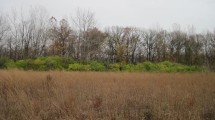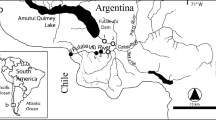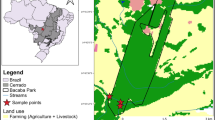Abstract
Invasion by Gleditsia triacanthos L. (honey locust) along the banks of Pampean streams and rivers appears to induce profound changes in species richness, macrophyte cover, and producer biomass. Seasonal effects of the invasion on macrophytes cover and biomass of seston, periphyton, and benthos were studied at three low order streams from the Pampas region (name them here), in sections with and without invasion of honey locust. We hypothesized that light reduction by honey locusts reduces macrophyte coverage and algal biomass, thereby modifying the structure of the stream communities. Incident light and nutrient concentrations showed differences between invaded and not invaded reaches. Stream sections with tree canopy showed a negative correlation with the percentage of macrophyte cover (R = -0.41, p < 0.05). In the three streams, the biomass of seston, periphyton and benthos was reduced in summer, when canopy cover was most developed. This study demonstrates that a high degree of honey locust invasion modifies the structure of aquatic communities of Pampean streams therefore urgent action is needed. Options for honey locust management are suggested.




Similar content being viewed by others
References
Acuña V, Vilches C, Giorgi A (2011) As productive and slow as stream can be: the metabolism of a pampean stream. Journal of the North American Benthological Society 30(1):71–83
APHA-WWA-WPCF (2005) Standard methods for the examination of water and wastewater. APHA-WWA-WPCF, Washington DC
Barling RD, Moore ID (1994) Role of buffer strips in management of waterway pollution: a review. Environmental Management 18:543–558
Bodí MB, Cerdà A, Mataix-Solera J, Doerr SH (2012) Efectos de los incendios forestales en la vegetación y el suelo en la cuenca mediterránea: revisión bibliográfica. Boletín de la Asociación de Geógrafos Españoles (58):33–55
Brown J, Carter J (1998) Spatial and temporal patterns of exotic shrub invasion in an Australian tropical grassland. Landscape Ecology 13:93–102
Bunn SE, Davies PM, Mosich D (1999) Ecosystem measures of river health and their response to riparian and catchement degradation. Freshwater Biology 41:333–345
Burrell TK, O’Brien JM, Graham SE, Simon KS, Harding JS, McIntosh AR (2014) Riparian shading mitigates stream eutrophication in agricultural catchments. Freshwater Science 33:73–84
Cabrera A, Willink A (1980) Biogeografía de América Latina. Organization of American States, Washington, DC
Capello V, de la Peña C (2007) Propuesta de manejo de acacia negra (Gleditsia triacanthos) en la cuenca del río Luján. Informe de gestión ambiental 2007. Secretaría de Política Ambiental, Buenos Aires
Carter V, Rybicki NB (1990) Light attenuation and submersed macrophyte distribution in the tidal Potomac River and estuary. Estuaries 13:441–452
Chaneton E, Mazia C, Machera M, Uchitel A, Ghersa CM (2004) Establishment of honey locust (Gleditsia triacanthos) in burned Pampean grasslands. Weed Technology 18:1325–1329
Colombo Speroni F, de Viana M (2001) Requerimientos de escarificación en semillas de especies autóctonas e invasoras. Ecología Austral 10:123–131
Csurhes S, Markula A (2010) Honey locust tree: Gleditsia triacanthos. Department of Employment, economic development and innovation. Queensland Goverment
Darley WM (1991) Biología de las algas: enfoque fisiológico. Limusa, México
Di Marzio W, Sáenz ME, Alberdi JL, Fortunato N, Tangorra M, Capello V, Ambrini G (2009) Estrategia de manejo de acacia negra (Gleditsia triacanthos) en la Cuenca del río Luján. Evaluación ecotoxicológica del herbicida Togar Bt. Revista argentina de ecotoxicologia y contaminación ambiental 1:1–7
Feijoo C, Rigacci L, Doyle S (2005) Ecological regionalization of pampean streams in Argentina. Verh. Internat. Verein. Limnol. 29:1–7
Feijoó C, Gantes P, Giorgi A, Rosso JJ, Zunino E (2012) Valoración de la calidad de ribera en un arroyo pampeano y su relación con las comunidades de macrófitas y peces. Biología Acuática 27:113–128
Ferreiro N, Giorgi A, Leggieri L, Feijoó C (2011) Effects of macrophyte heterogeneity and food availability on structural parameters of the macroinvertebrate community in a Pampean stream. Hydrobiologia 664:199–211
Ferreiro N, Giorgi A, Feijoó C (2013) Effects of macrophyte architecture and leaf shape complexity on structural parameters of the epiphytic algal community in a Pampean stream. Aquatic Ecology 47:389–401
Gantes P, Marano A, Rigacci L (2011) Changes in the decomposition process associated with the invasion of Gleditsia triacanthos (honey locust) in Pampean streams (Buenos Aires, Argentina). Journal of Freshwater Ecology 26: 481–494
Ghersa C, de la Fuente E, Suarez S, León R (2002) Woody species invasion in the rolling Pampa. Agriculture, Ecosystems and Environment 88:271–278
Giorgi A, Feijoó C, Tell G (2005) Primary producers in a Pampean stream: temporal variation and structuring role. Biodiversity and Conservation 14:1699–1718
Giorgi A, Vilches C, Rodriguez Castro C, Zunino E, Debandi J, Kravetz S, Torremorell A (2014) Efecto de la invasión de acacia negra (Gleditsia triacanthos L. (Fabaceae)) sobre la temperatura, luz y metabolismo de un arroyo pampeano. Acta biológica Colombiana 19:99–106
Gordon B, McMahon T, Finlayson B, Gippel C, Nathan R (2004) Stream hydrology. An introduction for ecologists. J. Wiley & sons, West Sussex
Grau HR, Aragón R (2000) Árboles invasores de la sierra de San Javier. In: Grau HR, Aragón R (eds) Ecología de árboles exóticos en las Yungas Argentinas LIEY. San Miguel de Tucumán, pp 5–20
Gutiérrez J, Jones C, Sousa R (2014) Toward an integrated ecosystem perspective of invasive species impacts. Acta Oecologica 54:131–138
Hill W (1996) Effects of light. In: Stevenson R, Bothwell M, Lowe R (eds) Algal ecology. Freshwater benthic ecosystems. Academic Press Inc., San Diego, pp 121–148
Hood WG, Naiman RJ (2000) Vulnerability of riparian zones to invasion by exotic vascular plants. Plant Ecology 148:105–114
Hudson W (1918) Far away and long ago: a childhood in Argentina. Dutton EP, London
Kalesnik F, Malvárez A (2003) Las especies invasoras exóticas en los sistemas de Humedales. El caso del Delta Inferior del Río Paraná. INSUGEO. CONICET - Universidad de Tucumán. Miscelánea 12:5–12
Keil G, Spavento E, Murace M, Millanes A (2011) Acacia blanca (Robinia pseudoacacia L.) y acacia negra (Gleditsia triacanthos L.): aspectos tecnológicos relacionados al empleo en productos de madera maciza. Forest Systems. 20:21–26
Kelly J, Kovar J, Sokolowsky R, Moorman T (2007) Phosphorus uptake during four years by different vegetative cover types in a riparian buffer. Nutrient cycling in agroecosystem 78:239–251
Kuntz C (2011) Ecología y uso del fuego en la región chaqueña argentina: una revisión. Boletín del CIDEU 10:81–105
Lavado R, Duymovich O, Jiménez J, Alvarez L (1982) Pérdidas de sustancias húmicas de suelos natricos a través del Río Samborombón. Revista del Museo de La Plata IX Ser. Secc. Geol. 76:97–103
Leggieri L (2010) Invasión de Gleditsia triacanthos en los corredores de los sistemas fluviales de la Pampa Ondulada y su efecto sobre la distribución de Myocastor coypus. Ecología Austral 20:201–208
Mack RN, Simberloff D, Lonsdale W, Evans H, Clout M, Bazzaz F (2000) Biotic invasions: causes, epidemiology, global consequences, and control. Ecological Applications 10:689–710
Marco D, Páez S (2000) Invasion of Gleditsia triacanthos in Lithraeae ternifolia montane forest of Central Argentina. Environmental Management 26:409–419
Martins Bruno-Soares A, Abreu J (2003) Merit of Gleditsia triacanthos pods in animal feeding. Chemical composition and nutritional evaluation. Animal Feed Science and Technology 107:151–160
Mohammed R, Abou Zeid A, El Hawary S, Sleem A, Ashour W (2014) Flavonoid constituents, cytotoxic and antioxidant activities of Gleditsia triacanthos L. leaves. Saudi Journal of Biological Science. 21:547–553
Muñoz-Vallés S, Gallego-Fernández J, Cambrollé J (2014) The role of the expansion of native-invasive plant species in coastal dunes: the case of Retama monosperma in SW Spain. Acta Oecologica 54:82.89
Quiroga PA, Juliá P (2011) Estudio de una Cuenca de río subtropical de montaña: pautas para su gestión. In: Fernández H, Barber H (eds) La Cuenca del río Lules: una aproximación multidisciplinaria a su complejidad. Edunt. San Miguel de Tucumán, pp 159–174
Richardson D (1998) Forestry trees as invasive aliens. Conservation Biology 12:18–26
Riis T, Biggs B (2003) Hydrologic and hydraulic control of macrophyte establishment and performance in streams. Limnology and Oceanography 48:1488–1497
Serra MN, Albariño R, Díaz Villanueva V (2012) Invasive Salix fragilis alters benthic invertebrate communities and litter decomposition in northern Patagonian streams. Hydrobiologia 701:173–188
Vilches C (2005) Comparación del metabolismo en productores del arroyo Las Flores. Thesis. Universidad Nacional de Luján
Vilches C, Giorgi A (2010) Metabolism in macrophyte-rich stream exposed to flooding. Hydrobiologia 654:57–65
Zalba SM, Villamil CB (2002) Woody plant invasion in relictual grasslands. Biological Invasions 4:55–72
Acknowledgements
This study was funded by the Agencia Nacional de Promoción Científica y Tecnológica through PICT No-0791/11 (Albariño), PICT N°1017/14 (Giorgi) and PICT N° 2450/14 (Vilches) and the “Universidad Nacional de Luján”. During the study, C. Rodríguez Castro was supported by grants from the Consejo Nacional de Investigaciones Científicas y Técnicas (CONICET). We thank Eduardo Zunino, Sebastián Kravetz and Juan Ignacio Debandi for their assistance and especially to the owner and employees of the “Hostería La Soleada” near the Balta stream, and Eng. Andrés Solá and Mr. Juan Rojas for enabling access to the study sites at Las Flores stream.
Author information
Authors and Affiliations
Corresponding author
Additional information
Publisher’s Note
Springer Nature remains neutral with regard to jurisdictional claims in published maps and institutional affiliations.
Rights and permissions
About this article
Cite this article
Vilches, C., Torremorell, A.M., Rodriguez Castro, M.C. et al. Effects of the Invasion of Honey Locust (Gleditsia triacanthos L.) on Macrophytes and Algae of Pampean Streams (Argentina). Wetlands 40, 321–331 (2020). https://doi.org/10.1007/s13157-019-01179-2
Received:
Accepted:
Published:
Issue Date:
DOI: https://doi.org/10.1007/s13157-019-01179-2




